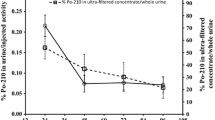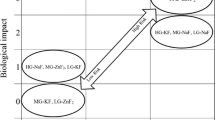Abstract
Rubidium has been considered to be nontoxic. Its use includes thin film on glass deposition and as medical contrast medium. Recent technology innovations also involve the use of rubidium, but there is limited information about the biological effects of its various compounds. In the present risk assessment study, a series of rubidium compounds with different counter anions—acetate, bromide, carbonate, chloride, and fluoride—were orally administrated in a single dose to several groups of rats. Cumulative 24-h urine samples were obtained, and the levels of rubidium, fluoride, N-acetyl-β-D-glucosaminidase and creatinine were measured to evaluate possible acute renal effects. Daily samples of serum were also obtained to determine the levels of aspartate and alanine aminotransferases to assess possible acute hepatic effects. Urinary rubidium excretion recovery of 8.0–10.5 % shows that urine can be a useful diagnostic tool for rubidium exposure. The present results reveal that rubidium shows different biological effects depending on the counter anion. A pattern of large significant NAG leakage and elevation of ALT observed in rats treated with anhydrous rubidium fluoride indicates renal and hepatic toxicities that can be attributed to fluoride. The techniques reported in this study will be of help to assess the potential risks of toxicity of rubidium compounds with a variety of anions.

Similar content being viewed by others

References
Pilon-Smits EA, Quinn CF, Tapken W, Malagoli M, Schiavon M (2009) Physiological functions of beneficial elements. Curr Opin Plant Biol 12:267–274
Anke M, Angelow L (1995) Rubidium in the food chain. Fresenius J Anal Chem 352:236–239
Yamagata N (1962) The concentration of common cesium and rubidium in human body. J Radiat Res 3:9–30
Nielsen FH (1996) How should dietary guidance be given for mineral elements with beneficial actions or suspected of being essential? J Nutr 126:2377S–2385S
Hass EM (2006) Staying healthy with nutrition, 21st century edition: the complete guide to diet & nutritional medicine celestial arts. Berkeley CA, USA
Yokoi K (1997) A study on possible essentiality nature of tin and rubidium. J Jpn Soc Nutr Food Sci 50:15–20
Williams RH, Maturen A, Sky-Peck HH (1987) Pharmacologic role of rubidium in psychiatric research. Compr Ther 13:46–54
Su Y, Chen LJ, He JR, Yuan XJ, Cen YL, Su FX, Tang LY, Zhang AH, Chen WQ, Lin Y, Wang SM, Ren ZF (2011) Urinary rubidium in breast cancers. Clin Chim Acta 412:2305–2309
Kasprowicz MJ, Dohnalik T, Jozefowski L, Rubahn K, Rubahn HG (2004) Diffusion of rubidium atoms in PDMS thin films. Chem Phys Lett 391:191–194
Kaster T, Mylonas I, Renaud JM, Wells GA, Beanlands RS, deKemp RA (2012) Accuracy of low-dose rubidium-82 myocardial perfusion imaging for detection of coronary artery disease using 3D PET and normal database interpretation. J Nucl Cardiol 19:1135–1145
Singh B, Dhawan D, Nehru B, Garg ML, Mangal PC, Chand B, Trehan PN (1994) Impact of lead pollution on the status of other trace metals in blood and alterations in hepatic functions. Biol Trace Elem Res 40:21–29
Greenwood IA, Weston AH (1993) Effects of rubidium on responses to potassium channel openers in rat isolated aorta. Br J Pharmacol 109:925–932
Meltzer HL, Lieberman KW (1971) Chronic ingestion of rubidium without toxicity: Implications for human therapy. Experientia 27:672–674
Canavese C, DeCostanzi E, Branciforte L, Caropreso A, Nonnato A, Pietra R, Fortaner S, Jacono F, Angelini G, Gallieni M, Fop F, Sabbioni E (2001) Rubidium deficiency in dialysis patients. J Nephrol 14:169–175
Tamano H, Enomoto S, Oku N, Takeda A (2002) Preferential uptake of zinc, manganese, and rubidium in rat brain tumor. Nucl Med Biol 29:505–508
Hayashi S, Usuda K, Mitsui G, Shibutani T, Dote E, Adachi K, Fujihara M, Shimbo Y, Sun W, Kono R, Tsuji H, Kono K (2006) Urinary yttrium excretion and effects of yttrium chloride on renal function in rats. Biol Trace Elem Res 114:225–235
Usuda K, Kono K, Dote T, Watanabe M, Shimizu H, Kawasaki T, Hayashi S, Nakasuji K, Fujimoto K, Lu B (2006) Survey of strontium in mineral waters sold in Japan: relations of strontium to other minerals and evaluation of mineral water as a possible dietary source of strontium. Biol Trace Elem Res 112:77–86
Tanida E, Usuda K, Kono K, Kawano A, Tsuji H, Imanishi M, Suzuki S, Ohnishi K, Yamamoto K (2009) Urinary scandium as predictor of exposure: effects of scandium chloride hexahydrate on renal function in rats. Biol Trace Elem Res 130:273–282
Ohnishi K, Usuda K, Nakayama S, Sugiura Y, Kitamura Y, Kurita A, Tsuda Y, Kimura M, Kono K (2011) Distribution, elimination, and renal effects of single oral doses of europium in rats. Biol Trace Elem Res 143:1054–1063
Fujita A, Kono K, Usuda K, Shimizu H, Fujimoto K, Kono R, Ohnishi K, Komiyama M, Yuko Nakatsuru Y, Mohiuddin, Tamaki J (2014) Precise determination of trace rubidium in biological fluid using inductively coupled plasma atomic emission spectroscopy. Bull OMC 59:69–74
Usuda K, Kono K, Shimbo Y, Fujihara M, Fujimoto K, Kawano A, Kono R, Tsuji H, Tanida E, Imanishi M, Fukuda C, Suzuki S, Tanaka H (2007) Urinary fluoride reference values determined by a fluoride ion selective electrode. Biol Trace Elem Res 119:27–34
Usuda K, Kono K, Dote T, Nishiura K, Miyata K, Nishiura H, Shimahara M, Sugimoto K (1998) Urinary biomarkers monitoring for experimental fluoride nephrotoxicity. Arch Toxicol 72:104–109
Usuda K, Kono K, Dote T, Nishiura H, Tagawa T (1999) Usefulness of the assessment of urinary enzyme leakage in monitoring acute fluoride nephrotoxicity. Arch Toxicol 73:346–351
Usuda K, Kono K, Dote T, Watanabe M, Shimizu H, Tanimoto Y, Yamadori E (2007) An overview of boron, lithium, and strontium in human health and profiles of these elements in urine of Japanese. Environ Health Prev Med 12:231–237
Barr DB, Wilder LC, Caudill SP, Gonzalez AJ, Needham LL, Pirkle JL (2005) Urinary creatinine concentrations in the U.S. population: implications for urinary biologic monitoring measurements. Environ Health Perspect 113:192–200
Willis LR, McCallum PW, Higgins JT Jr (1976) Exaggerated natriuresis in the conscious spontaneously hypertensive rat. J Lab Clin Med 87:265–272
Khanna A, Kurtzman NA (2006) Metabolic alkalosis. J Nephrol 19(Suppl 9):S86–96
Bourbouze R, Baumann FC, Bonvalet JP, Farman N (1984) Distribution of N-acetyl-beta-D-glucosaminidaseisoenzymes along the rabbit nephron. Kidney Int 25:636–642
Whiting PH, Brown PA (1996) The relationship between enzymuria and kidney enzyme activities in experimental gentamicin nephrotoxicity. Ren Fail 18:899–909
Dabrowska E, Letko R, Balunowska M (2006) Effect of sodium fluoride on the morphological picture of the rat liver exposed to NaF in drinking water. Adv Med Sci 51(Suppl 1):91–95
Pereira HA, Leite Ade L, Charone S, Lobo JG, Cestari TM, Peres-Buzalaf C, Buzalaf MA (2013) Proteomic analysis of liver in rats chronically exposed to fluoride. PLoS One 8:e75343. doi:10.1371/journal.pone.0075343
Cao J, Chen J, Wang J, Jia R, Xue W, Luo Y, Gan X (2013) Effects of fluoride on liver apoptosis and Bcl-2, Bax protein expression in freshwater teleost, Cyprinuscarpio. Chemosphere 91:1203–1212
Bulathsinghala AT, Shaw IC (2014) The toxic chemistry of methyl bromide. Hum Exp Toxicol 33:81–91
Carrieri M, Magosso D, Piccoli P, Zanetti E, Trevisan A, Bartolucci GB (2007) Acute, nonfatal intoxication with trichloroethylene. Arch Toxicol 81:529–532
Burns MJ, Linden CH (1997) Another hot tub hazard. Toxicity secondary to bromine and hydrobromic acid exposure. Chest 111:816–819
Araz C, Cekmen N, Erdemli O, Soylu L, Atalay F, Demirbaş TA, Demirbağ A, Celep B (2013) Severe gastrointestinal burn with hydrochloric acid. J Res Med Sci 18:449–452
Acknowledgments
The Japan Society for the Promotion of Science supported this study through a Grant-in-Aid for Scientific Research (JSPS KAKENHI) for scientific research (C) Number 25460822.
Author information
Authors and Affiliations
Corresponding author
Rights and permissions
About this article
Cite this article
Usuda, K., Kono, R., Ueno, T. et al. Risk Assessment Visualization of Rubidium Compounds: Comparison of Renal and Hepatic Toxicities, In vivo. Biol Trace Elem Res 159, 263–268 (2014). https://doi.org/10.1007/s12011-014-9937-3
Received:
Accepted:
Published:
Issue Date:
DOI: https://doi.org/10.1007/s12011-014-9937-3



